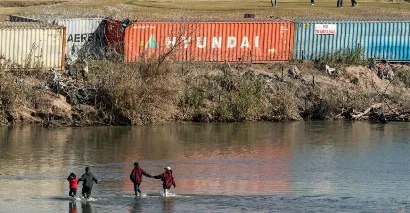Key Highlights
The pursuit of the American Dream has long been a powerful magnet, drawing millions to the shores of the United States. For many Indian nationals, however, the legal pathways are too long, restrictive, and often unattainable. This desperation has fueled the rise of the 'Dunki' route, a treacherous and costly illegal migration pathway that sees thousands risk their lives, futures, and fortunes in a desperate hop across continents. This blog delves into the mechanics, the dangers, and the devastating consequences of this clandestine journey.
The Origin and Meaning of the 'Dunki' Route
The term "Dunki" originates from Punjabi slang, literally meaning "to hop from place to place." It perfectly captures the essence of this irregular migration. It is an illegal passage used by individuals seeking to enter the United States or other Western nations without the necessary documentation, relying instead on a network of human smugglers and sheer endurance.
This dangerous pathway has gained notoriety as a means to circumvent the highly difficult and lengthy processes of obtaining a legal US visa. The route is not a direct path but a series of interconnected, clandestine crossings through multiple international borders, primarily stretching across Latin America. The very name highlights the sequential, often frantic, nature of the journey as migrants are moved secretly from one point to the next.
The entire operation is orchestrated by sophisticated human-smuggling networks—known as "agents" in India. These organisations charge exorbitant fees, often running into lakhs of rupees, promising safe passage and delivery to America. However, the promise rarely matches the perilous reality, leaving many migrants vulnerable to exploitation, harm, and financial ruin.
The Economic and Societal Drivers
The primary force driving migrants to the Dunki route is the significant economic pressure and the hope for a better life. In regions like Punjab, Haryana, and Gujarat, families view securing a foothold abroad as the ultimate investment in their future. The lack of lucrative opportunities at home fuels the belief that the risks are justified for the potential rewards overseas.
The migrants often come from agricultural or working-class backgrounds, pooling their life savings, selling ancestral land, or taking on massive loans to fund the journey. For instance, deportees have reported costs ranging from ₹35 lakh to over ₹57 lakh, an investment that represents years of family income. This financial gamble is driven by the conviction that even low-paying jobs in the US will allow them to send back remittances far greater than anything they could earn domestically.
The Allure of the American Dream
The cultural perception of the American Dream in these regions is heavily romanticised. Success stories, whether real or exaggerated, circulate widely, reinforcing the notion that sacrifice today guarantees prosperity tomorrow. This collective aspiration for upward mobility often overshadows the immense dangers and moral ambiguity of illegal immigration, pushing families to support these desperate measures.
For many, the American landscape promises not just wealth but also a respectable social standing upon their return or an easier life for their children. This yearning for recognition and an escape from societal limitations in India makes the extreme financial and physical risks seem like a necessary rite of passage. The high costs reflect the desperate demand for this seemingly exclusive pathway to success.
Also Read: Cost of Transit Visa for USA: New Fees & Process Guide
The Barriers of Legal Immigration
The rigid framework of legal immigration acts as a strong deterrent for those lacking formal education, specialised skills, or substantial financial resources required for investor or skilled worker visas. The lengthy visa processing times, coupled with strict eligibility criteria, essentially close the door on a significant portion of the aspiring migrant population from states like Punjab and Haryana.
Therefore, the Dunki route becomes the only perceived option for those who cannot navigate the legitimate system. They are often victims of circumstance—individuals who are willing to work hard but cannot qualify for legal entry. The smugglers exploit this systemic bottleneck, capitalising on the desperation born from limited legal alternatives and immense personal ambition.
Mapping the Perilous Path
The Dunki route is a sophisticated and multinational operation, spanning thousands of miles and often taking several months to complete. It is a calculated path of least resistance, beginning with an air flight and ending with a dangerous border crossing into the US. The route's complexity is designed by agents to avoid direct scrutiny from international border agencies.
The Initial Contact and Financial Stakes
The journey begins in India with the involvement of local agents who act as intermediaries for larger, transnational smuggling syndicates. These agents collect fees that can total well over ₹40 lakh to ₹1 crore, depending on the guaranteed destination and the level of assistance promised. The payments are often phased, ensuring the migrants remain dependent on the agents for the next leg of the journey.
These networks are highly fluid and adapt quickly to changing border enforcement policies. Recent investigations by Indian authorities, including the Enforcement Directorate (ED) and state police, confirm that these syndicates are deeply entrenched, facilitating this multi-crore racket. The money fuels corruption and perpetuates the cycle of illegal migration, often at great human cost.
The South American Entry Point
The first stage involves securing a flight to a South American country with relaxed visa rules for Indian citizens. Common initial destinations include Ecuador, Bolivia, Guyana, or Brazil. These countries serve as convenient gateways, where the migrants can officially enter and then immediately begin the clandestine overland journey northward toward the US border.
Once they land, the legitimate part of the trip ends, and the perilous, unsanctioned movement begins. From these starting points, the migrants are handed over to local affiliates of the smuggling network who arrange the transport through multiple countries. This transfer of control means migrants are constantly exposed to new dangers and uncertainty in unfamiliar territories.
Also Read: Difference Between B1 and B2 Visa USA: Experts New Guide
The Heart of the Danger: The Darién Gap
The journey through South and Central America culminates in the most formidable and feared obstacle on the Darién Gap: the Darién Gap. This is an unbroken stretch of dense, roadless jungle straddling the border between Colombia and Panama. It represents an area of utter lawlessness and extreme natural danger, where survival is not guaranteed.
Migrants are forced to travel for days on foot through an environment characterised by deep swamps, surging rivers, and rough, unforgiving terrain. The risks are manifold: not only do they face exhaustion, hunger, and illness from exposure, but they are also targets for predatory criminals. Reports of robbery, assault, and abandonment are tragically common among those who survive the crossing.
Surviving the Treacherous Terrain
Navigating the Darién Gap is a brutal test of human will and physical limits. Smugglers offer minimal assistance, often disappearing or demanding additional payments mid-trek. Many migrants lose their scant belongings, including identification or life-saving supplies, to the jungle or to criminal gangs. The psychological trauma of witnessing injury, death, or abuse along this stretch leaves indelible scars on the survivors.
Those who manage to emerge from the Gap continue their journey through a succession of Central American nations: Costa Rica, Nicaragua, Honduras, and Guatemala. In these countries, travel is often managed by local facilitators who cram migrants into unsafe vehicles, buses, or boats, navigating checkpoints and hostile territory in a constant state of fear.
The Final Stretch and Rising Apprehensions
The final leg of the Dunki route leads to Mexico, the last barrier before the US border. Migrants converge in southern towns like Tapachula or border cities like Ciudad Juárez, exhausted and financially drained. It is here that they prepare for the final, critical decision: attempting an illegal crossing or surrendering to US authorities to claim asylum.
Smugglers, often controlling the final crossing points, exploit the migrants' desperation by demanding further, unscheduled payments for what they deem "safe passage." Many migrants choose the route of surrender, hoping the US asylum system will grant them refuge. However, this often leads directly to prolonged detention and, increasingly, swift deportation.
The Mexican Gathering Points
The cities on the US-Mexico border have become critical hubs where migrants must wait for their opportunity or for instructions from their handlers. The environment is fraught with danger, as they face the risk of kidnapping, exploitation by cartels, and constant fear of apprehension by Mexican or US border patrol agents. The vast, often desolate landscapes of the US-Mexico border, including deserts and riverbeds, present their own set of environmental hazards.
The surging numbers are alarming. US Customs and Border Protection data indicates that over 97,000 Indian nationals were detained at the US–Mexico border in 2024, marking a massive leap from previous years. This statistic highlights both the growing popularity of the route and the increased enforcement efforts by US authorities to intercept and process those arriving.
Also Read: How Many Years is IELTS Valid? New Update and Insights
The Harsh Reality: Detention, Deportation, and Debt
For the vast majority of Dunki route migrants, the dream ends abruptly, often in detention. The stories of deportees are harrowing, revealing the brutal reality that lies beneath the promises of the agents. Harjinder Singh, a 45-year-old from Ambala, recounted his experience of being shackled for 25 hours on a deportation flight after being detained by US authorities.
The migrants return home with nothing but shattered hopes and colossal, often unmanageable, debt. Another deportee, Naresh Kumar, revealed he spent 57 lakh and was detained for 14 months before being sent back. The financial ruin extends beyond the individuals; it devastates entire families who sold assets or borrowed heavily, turning dreams of prosperity into lifelong debt bondage.
The consequences are not merely financial or physical; they are deeply psychological and social. Deportees often return home to face shame and public scrutiny, with many families refusing to speak about the experience. The failed journey results in a social stigma, compounding the trauma of detention, abuse, and the massive waste of family resources.
The Numbers Speak: A Surging Crisis
The Dunki phenomenon is not a historical footnote but a rapidly escalating crisis. The detention figures clearly demonstrate the scale of the increase in irregular Indian migration attempts via this route. The rising number puts immense strain on US detention facilities and the immigration legal system, while simultaneously fueling the smuggling industry.
Early in 2025, the US deported over 250 Indian nationals in multiple flights, including those from key sending states like Haryana. These actions, while necessary for border control, serve as stark warnings to those considering the path. The cycle of large payments, dangerous travel, detention, and deportation underscores the tragic inefficiency and risk inherent in the Dunki route.
Conclusion
The mapping of the Dunki route reveals a heartbreaking saga of hope, desperation, and exploitation. Driven by potent economic factors and the difficulty of legal immigration, thousands of ambitious Indian nationals are placing their lives and fortunes in the hands of ruthless smugglers. The journey through the Darién Gap, across Central America, and to the US border is riddled with financial extortion, physical harm, and the near-certainty of detention or deportation. The result is often lifelong debt and shattered dreams, demonstrating that this clandestine path, born of hope, overwhelmingly ends in tragedy. The Dunki route remains a perilous gamble that few win, and many lose everything. Visit TerraTern now to know more.








